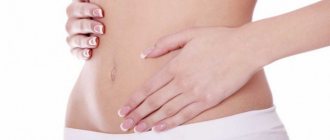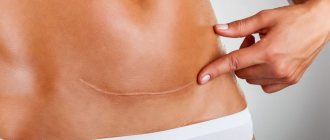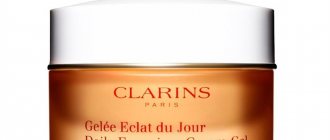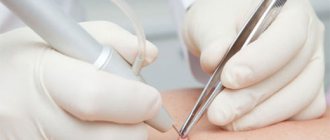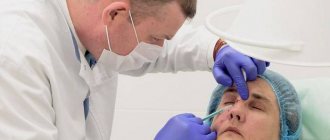Indications for taping
Taping the abdominal muscles is recommended for:
- Presence of local fat deposits
- Development of cellulite
- The appearance of sagging, sagging and stretch marks in the abdominal area after childbirth or after rapid weight loss
- The presence of diastasis of the rectus abdominis muscles, that is, their stretching
- Presence of a scar after cesarean section
Under the influence of tapes, the metabolic process intensifies, the cells are actively saturated with oxygen, rejecting excess fluid and recovering. Today, abdominal taping for diastasis has gained popularity among women who, after pregnancy, want to quickly tighten their stomach.
Lymphatic drainage taping
Lymphatic drainage kinesio taping will help eliminate stretch marks and sagging skin after pregnancy, as well as tone muscles. Such applications are aimed at removing excess fluid from the intercellular space, saturating cells with useful substances and launching regenerative processes. To carry out drainage taping, you need to prepare a standard tape - cut it into a “noodle” shape - according to the instructions in the diagram. Or you can purchase ready-made pre-cut kinesio tape. It is important to note that such applications are glued without tension, and the “anchors” are located in the area of the accumulation of lymph nodes. An example of a lymphatic drainage application for the abdomen in the photo below:
Perforated tapes help achieve enhanced lymphatic correction. Unlike standard ones, they do not need to be pre-cut. There are special slots along the entire surface of such kinesio tapes, which provide a lymphatic drainage effect. Due to the fact that different pressure is created on the tissue in the taped area, the flow of lymph and blood flow accelerates. Therefore, recovery processes occur more intensely. Lymph tapes with perforation actively fight not only stretch marks and sagging skin, but also cellulite, subcutaneous fat deposits, hematomas, lymphostasis, scars and many others. More information on how to use lymphatic kinesio tapes for aesthetic correction of the abdomen can be found in the instructions.
What types are there?
Products intended for adults and children are available in various shapes, widths and lengths. Which plaster is best to use after suture surgery depends on the size of the wound and its location. Pharmacies offer the following types:
- COSMOPOR Antibacterial. It is a breathable bandage with silver. Used for infected wounds or when there is a high probability of infection. It absorbs moisture well, does not cause allergies, is easy to remove, and can be used at home;
- Hudrofilm. Postoperative sutures dissolve and are used during the wound healing stage to avoid re-infection. It is transparent, has an absorbent pad made of polyurethane film;
- Fixopor. Sterile plaster used for moving, round parts of the body. Has a porous structure;
- Cosmopore E. Use only on uninfected wounds. It is self-adhesive, can use for sensitive skin.
A patch for healing postoperative sutures of any kind, accelerates the healing process, is easy to use, protects and prevents infection. The main thing is to follow the recommendations of your doctor to choose the appropriate dressing option.
Taping for diastasis
After childbirth, women may experience severe separation of the rectus muscles in the abdominal area (diastasis). Using kinesio taping in combination with proper nutrition can bring your abdominal muscles back to normal. Taping diastasis in comparison with other methods of postpartum restoration of the rectus muscles has a number of advantages:
- this method is painless and comfortable;
- therapy is characterized by low cost;
- Taping can be combined with physical exercise;
- tape has a 24-hour effect on the body.
For your information! If the application of the tapes was carried out correctly, the tapes may not be removed from the abdomen throughout the week. The water resistance of the material that underlies the tapes allows you to shower and swim in the pool.
It has been proven that thanks to the tapes, tissues are restored faster. Taping for diastasis helps:
- Minimize the sensation of pain;
- Support the muscles in the area of injury;
- Stimulate blood movement with further elimination of stagnant processes;
- To tone flabby muscles, eliminate overstretching;
- Form the correct muscle corset.
Tapes are applied to the rectus abdominis muscles in women who have given birth while lying on their back. Tapes are applied across the entire width of the stretched muscles, tightening them up to 50%. Here you should know that the base ends of kinesio tapes are glued without tension. Taping of diastasis should last 2 - 6 months until the muscles return to normal.
Forum Wisdom: Am I Pregnant?
When to take a pregnancy test?
Delay, negative test...
Will the test show before the delay?
Stomach hurts like menstruation
Is it possible to feel the implantation of an embryo?
Coitus interruptus
Can the lower abdomen hurt in early pregnancy?
Signs of pregnancy before delay
How does a miscarriage occur?
Intrauterine device
Why him? Without any bandage, I took a shower after 12.
In this section, only neutral information is published in topics and comments. Topics and comments containing advice, recommendations, promotion of alternative methods of treatment or other actions will be closed.
They stuck this on me in the Moscow maternity hospital. It’s a great thing, it holds the seam and you can take a shower.
I had a good seam, an internal one, there were no threads or staples. After 3 days, the patch was removed, the seam was treated, and then I only wiped it myself at home with something disinfectant.
Ask at the pharmacy, they will tell you.
Also buy yourself some fishnet shorts; although they are disposable, they wash perfectly. Take a couple. It's really easier with them. And the stomach is held back from shaking, and nothing leaks, and postpartum pads do not wiggle in them. As soon as my milk came in, I was sweating profusely, flowing like streams, and it was still very hot in the maternity hospital. Well, a bandage wouldn’t be amiss either.
Why him? Without any bandage, I took a shower after 12.
Yes, you can go underwater, but it’s much easier to move with a plaster. And walk and sit down on the toilet. The seam does not warp due to every minute movements, does not displace the tissues, and the plaster holds them in place. Great stuff! It doesn't hurt as much with him.
New features and design have appeared for the version of the Woman.ru Forum on computers. Tell us, what are your impressions of the changes?
They had a Caesarean in Mopts, their bandage (like a cosmopore) was removed on the second day, then they simply applied a folded bandage, they didn’t cover it up anymore. The skin breathes, regeneration is more active. You can swim on the fourth day, just do not rub the seam with a washcloth. Regular postoperative bondage holds the suture better than a plaster; by the way, it will help tighten the stomach faster.
I had a CS 8 years ago. They didn’t glue anything. The threads were self-absorbing. Black in color)))) We also joked “what a horror, we were attacked with black threads!”
Showering was only allowed for the 3rd day. Nothing warped or shifted
Does a postpartum bandage really help you get rid of your belly faster? When can I wear it?
I went to local pharmacies and they didn’t know about this patch. Maybe someone remembers the name of the manufacturer?
Does a postpartum bandage really help you get rid of your belly faster? When can I wear it?
Helped me (my comment 4). I put it on as soon as I decided to get back on my feet - 10 hours after the operation. The bondage holds the muscles and the seam well, it makes it easier to walk with it, and yes, the stomach retracts quite quickly. It took me about three weeks to reach the pre-pregnancy state. Muscle tone, of course, is still rather weak, but the belly no longer hangs
2 months ago caesarean section, maternity hospital 10, Moscow. I think the patch lasted for 2-3 days - it was applied at the end of the operation. Then they took me off and allowed me to take a shower.
The doctor advised me to wear a bandage, but I had one that would put pressure on the seam - I didn’t.
Girls, do you carry the child in your arms after the operation or does someone help you?
Girls, do you carry the child in your arms after the operation or does someone help you?
I carried it. he's light
Helped me (my comment 4). I put it on as soon as I decided to get back on my feet - 10 hours after the operation. The bondage holds the muscles and the seam well, it makes it easier to walk with it, and yes, the stomach retracts quite quickly. It took me about three weeks to reach the pre-pregnancy state. Muscle tone, of course, is still rather weak, but the belly no longer hangs
+10000 buy disposable panties, but a size larger than yours, because the elastic should not fall on the seam, but should be higher than it (there is nowhere lower)) and pads for women in labor and a post-operative (not postpartum) bandage. it should be wide. then ask him to help dress him correctly (they dress him while lying down and there should be some kind of breathable layer under him (such as a shirt or a long T-shirt). wash only on the 3rd day. not earlier. even if you are allowed, it is unlikely that you will not It hurts and you can crawl up there and wash yourself completely normally. You want to, but it doesn’t always work out. You can just barely wash yourself.
Oh, they stuck some kind of plaster on me to speed up the healing of the seam, as they said. But I don’t know what it looks like because I was afraid to look at that place at first :) I didn’t take a shower with it, but not because of the plaster, but because Despite the fact that for the first 3 days I had no strength + pain, I simply couldn’t lift my leg into the bath.
Girls, do you carry the child in your arms after the operation or does someone help you?
I was alone with my twins. Very weak, crooked, but anything is possible.
By the way, I crawled into the shower because I was very dirty after the operation up to my ears.
Take small bottles of water to the hospital, you really want to drink, a large bottle is hard to lift and it’s uncomfortable to drink from a mug.
I wore the bandage for about 3 weeks after the operation. It makes it easier to get up and sit down, and in the maternity hospital the stomach does not sway))) The seam does not bother me.
They had a Caesarean in Mopts, their bandage (like a cosmopore) was removed on the second day, then they simply applied a folded bandage, they didn’t cover it up anymore. The skin breathes, regeneration is more active. You can swim on the fourth day, just do not rub the seam with a washcloth. Regular postoperative bondage holds the suture better than a plaster; by the way, it will help tighten the stomach faster.
It probably depends on the stitch, on tissue regeneration, they didn’t apply any bandages to me, the stitch practically healed and tightened. Three days of patching and that’s it.
Girls, do you carry the child in your arms after the operation or does someone help you?
I couldn’t even walk for the first 2-3 days. In addition to the stitch itself, my shoulders hurt a lot (throbbing pain), I got out of bed 2-3 times only to go to the toilet and for the laser. She walked barely crooked. I had no strength at all. One time I almost fainted.
Taping after caesarean section
After a cesarean section, scars may remain for a long time with some discomfort, hindering movement. To restore the tissue of long-lasting scars, both fresh and old, it makes sense to use tapes. In practice, it has been noted that during the taping process, the process of tissue regeneration is enhanced, scars become shallower, and the skin becomes smoother.
Seam taping is performed by placing a mesh crosswise over the scar. The location of the strips should be diagonal with respect to the lymph flow. The tension of the tape depends on the condition of the scars. A well-fused scar allows for strong tension. It should be remembered that strips should be applied to scars with folds.
In cases where the wound has not healed sufficiently, kinesio taping of the abdomen is possible only in areas located next to the suture. This factor will allow the wound to heal faster. Taping a healed scar is done as follows:
- The elastic tape is cut lengthwise into narrow strips of 1-1.5 cm.
- If the scar has healed well, then the tension can be 85% (but no more). If the scar after a cesarean section has healed recently, then the tension becomes weak.
Simultaneously with taping the scar after a cesarean section, you can stick tapes on the rectus and oblique abdominal muscles using the method described above.
What are the advantages
Its many advantages include the following:
- It adheres well to the skin, thanks to the special glue applied to the edges of the bandage;
- When removed, the patient does not experience painful or unpleasant sensations, no irritation or redness appears on the skin, and the scar itself is not injured;
- Made from natural, breathable materials. hypoallergenic materials;
- It has good hygroscopicity on the inside, so it does not stick to the seam, but at the same time perfectly absorbs all secretions;
- Affordable price;
- The seam has an aesthetically attractive and neat appearance;
- Does not hinder movement, does not create discomfort or unpleasant sensations when worn.
The advantages of the medical postoperative patch include the fact that it is available in various sizes: small, medium, large. It can be used for various parts of the body. It has convenient, individual, sterile packaging. You can purchase it individually or in a whole pack.
Contraindications
Along with the positive results that kinesio taping promises, this method has a number of contraindications. Typically, abdominal taping for diastasis is prohibited if:
- there are skin diseases (open wounds, dermatitis);
- there is fever and swelling after an illness;
- thrombosis diagnosed;
- cancer occurs and metastases are detected;
- there are diseases of unknown etiology (in this case, glued tapes can lead to unwanted complications);
- Diabetes mellitus has been diagnosed (in this case, consultation with an endocrinologist will be required).
Since applying tapes is not allowed on wounds and injured areas, in cases where applying tapes is unavoidable, an antiseptic pad or sterile material is applied to a small area of skin. This factor will not allow infection to enter the wound or provoke allergies. Considering the presence of serious contraindications to taping, experts recommend resorting to the services of specialists. The health worker will be able to correctly assess the person’s condition and, using the method of palpation and visual inspection, identify contraindications to the procedure.
If you ignore the help of a specialist, there may be a risk of swelling due to improper taping. In such a situation, you will need to immediately remove the bandage and adjust its application. Only a specialist will be able to make the right decision based on the patient’s well-being regarding reapplication of strips or refusal to use the technique described above.
Where and how it is used
I often use it in surgical and traumatology practice, especially if there is heavy discharge or the wound is bleeding. It can also be used at home for cuts and various injuries. In this case, it is necessary to select the appropriate size of the dressing for the wound. It should completely cover the wound and protrude beyond its edges by a centimeter on each side.
Before use, you must read the instructions and strictly follow the recommendations described therein. To begin with, the damaged area is disinfected, treated, dried, if there is hair around the damaged area, it is shaved off. Then the protective film is removed from the postoperative dressing patch and it is tightly glued to the required area. It can be changed every day with dressings or once every 2 or 3 days, depending on the recommendation of the attending physician.
